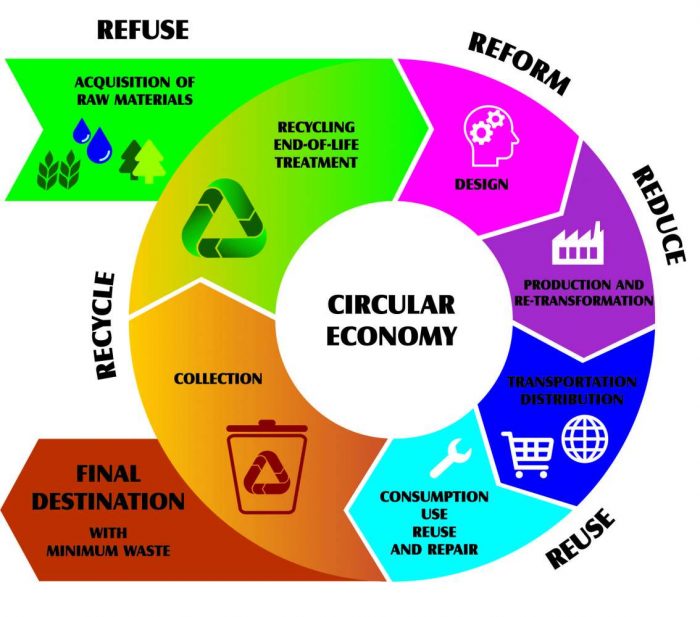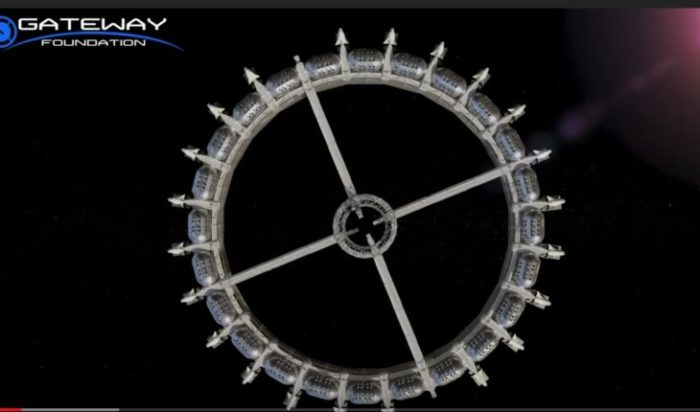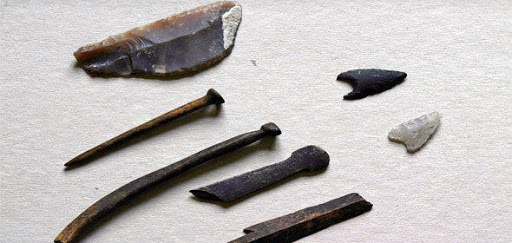Jan
28
2021
A recent study looks at the use of food waste to produce beneficial bacteria and nutrients for agriculture. Specifically they take beer mash and mixed produce discarded from a grocery store. They ferment it, and then add the result to the closed watering system of a greenhouse. The results are very encouraging – a significant increase in beneficial bacteria and carbon without any increase in pathogenic bacteria. In the US we waste about 50% of the food we grow and recycle only about 20% of it, so there is a huge untapped potential to return that food waste to the food-production stream. This system, if it works out, might add one method for doing so.
looks at the use of food waste to produce beneficial bacteria and nutrients for agriculture. Specifically they take beer mash and mixed produce discarded from a grocery store. They ferment it, and then add the result to the closed watering system of a greenhouse. The results are very encouraging – a significant increase in beneficial bacteria and carbon without any increase in pathogenic bacteria. In the US we waste about 50% of the food we grow and recycle only about 20% of it, so there is a huge untapped potential to return that food waste to the food-production stream. This system, if it works out, might add one method for doing so.
Such systems are an example of a circular production economy, rather than a linear system that begins with a natural resource and ends in a landfill. Linear systems are not indefinitely sustainable, as is becoming increasingly apparent as we approach 8 billion people on this planet. Anything we do on a global scale, like growing food, is going to be a stress on natural resources, including the availability of land.
Some argue, cruelly, in my opinion, that the best solution is to reduce the human population. I do think we need to ultimately get to a stable population, and the evidence shows an effective way to do this is to both combat poverty and promote women’s rights. This is then a win-win all around. We don’t have to starve people to death (people who propose this are never the ones who would starve), nor do we have to ban reproductive rights.
Eventually getting to a stable population in the billions, while a good thing, is not going to solve by itself the many issues of sustainability. Further, even if linear production from resource to landfill does not exhaust a specific resource it is still inefficient. So you don’t have to believe that we have or will reach “peak” whatever in order to see the advantages of designing a circular production economy.
Continue Reading »
Jan
26
2021
 Some spiritualists claim to be “clairaudient” which means they can hear voices, usually of spirits of the the dead. Some claim to be clairvoyant, which means they can see things remotely (from a different place and/or time), while still others claim clairsentience, meaning that they can feel emotions or sensations from objects or places. There is no credible scientific evidence that any of this is real, meaning that they represent genuine extrasensory perception (ESP), or the perception of genuine external information through non-physical (or at least unknown) means. There is also no plausible mechanism for such phenomena. This doesn’t make such phenomena strictly impossible, just highly unlikely, and sets a very high bar for evidence to be convinced they are real.
Some spiritualists claim to be “clairaudient” which means they can hear voices, usually of spirits of the the dead. Some claim to be clairvoyant, which means they can see things remotely (from a different place and/or time), while still others claim clairsentience, meaning that they can feel emotions or sensations from objects or places. There is no credible scientific evidence that any of this is real, meaning that they represent genuine extrasensory perception (ESP), or the perception of genuine external information through non-physical (or at least unknown) means. There is also no plausible mechanism for such phenomena. This doesn’t make such phenomena strictly impossible, just highly unlikely, and sets a very high bar for evidence to be convinced they are real.
When a person claims to hear, see, or feel something through ESP, then, what is happening? Likely, many different things. In some cases there is good reason to suspect (or there is even solid evidence) that the person is simply lying. Convincing others that you have special access to hidden knowledge can be lucrative. But assuming that in at least some cases the person claiming to experience ESP is sincere, what is happening? (And to be clear, this is not a strict dichotomy, as there is a full spectrum of people mixing sincere belief with “shortcuts”.) Is this all a learned behavior, or are some people neurologically or psychologically predisposed to the subjective experience of ESP?
Continue Reading »
Jan
25
2021
 The latest internet conspiracy theory involves a phone call between President Biden and Boris Johnson’s. Johnson is the first world leader that Biden has called as president, and the moment has been captured in photographs. What I find most amazing about these pictures is that it is 2021 and the phone at No 10 still has a cord. Perhaps there is a security reason for this. But what “the internet” found most interesting was the lack of cord – in the reflected images in the mirror, that is. This observation even confused journalists:
The latest internet conspiracy theory involves a phone call between President Biden and Boris Johnson’s. Johnson is the first world leader that Biden has called as president, and the moment has been captured in photographs. What I find most amazing about these pictures is that it is 2021 and the phone at No 10 still has a cord. Perhaps there is a security reason for this. But what “the internet” found most interesting was the lack of cord – in the reflected images in the mirror, that is. This observation even confused journalists:
Even ITV political editor Robert Peston admitted he was left bemused by the image.
He tweeted: “This is flipping weird. The phone cable should be visible in the mirror descending from Boris Johnson’s watch, in this official Downing St picture. It’s not. What is going on?”
This may become the latest blue dress – gold dress internet sensation. When I look at those pictures I absolutely see a phone cord, no problem. But – I can see how someone might, at first, be confused. There is a mild optical illusion created by the angle of the cord in the reflection vs the primary picture. While this is likely to blow over quickly as just a silly internet phenomenon, it does reflect (pun intended) a couple of phenomena worth pointing out.
Continue Reading »
Jan
22
2021
 In the Hitchhiker’s Guide to the Galaxy series, in the Restaurant at the End of the Universe, we find faithful adherents who have been waiting literally to the end of time for the return of their prophet. Now that’s dedication – but more on point, that is some extreme motivated reasoning. It turns out, the prophet does return to usher in a new age of utopia, literally with 1 second left to the universe.
In the Hitchhiker’s Guide to the Galaxy series, in the Restaurant at the End of the Universe, we find faithful adherents who have been waiting literally to the end of time for the return of their prophet. Now that’s dedication – but more on point, that is some extreme motivated reasoning. It turns out, the prophet does return to usher in a new age of utopia, literally with 1 second left to the universe.
While this is humorous fiction, it does highlight a reality of human psychology. Over the centuries there have been many doomsday or other cults who instilled their followers with the firm belief that something dramatic would happen at a specific time. This could be the second coming, the apocalypse, the rapture, or beaming onboard alien spaceships. The point is that something undeniably huge was supposed to happen, something you cannot pretend did happen when it didn’t. Cult followers who likely gave up their lives, all their worldly possessions, their relationships outside the cult, and often their reputations – all for that one glorious event – then have to face the reality that it did not happen. Often the cult leader will say something along the lines of, “Oops, I forgot to carry the 2, the world will end next Tuesday. But this is only a temporary reprieve, and does not change the fact that the leader was wrong, and can no longer claim infallibility.
When smacked in the face with undeniable reality, what do most people in these extreme situations do? Our initial instinct (probably from imagining ourselves in that situation) is that, as painful as it may be, reality will finally settle and they will have to admit the whole thing was a scam. But of course that is not what typically happens. Most people in that situation double down, dedicate themselves even more fanatically to the cult’s core beliefs, and go on a recruiting drive. Psychologically it is clear why they might do this – the fantasy is easier to deal with than the harsh reality. What really surprises people is the nimbleness of the mental gymnastics necessary to maintain false belief directly in the strong headwinds of reality. This is where motivated reasoning comes in.
We are now witnessing this moment of reckoning with another cult – Q-anon. Make no mistake, this is a conspiracy theory based cult. Believers in Q have been lead to believe absurd things, the core being that the world is being run by a ring of Satan-worshiping pedophiles (we known them as Democrats). Perhaps even more improbable is the claim that Trump is secretly a genius who has been tirelessly working to save the world. Everything that has happened over the last four years, from the Mueller investigation to the impeachment, was a false flag hiding Trump’s true agenda. And like the Cylons – Trump had a plan, even if we did not know exactly what it was.
Continue Reading »
Jan
19
2021
 This was inevitable. We are in the midst of a massive rollout of two new vaccines for COVID-19. Anxiety and fatigue levels from the pandemic are already running high, and there is a pre-existing anti-vaccine movement who is sure to exploit this. But perhaps most significantly, we are now living in a post-social media world. Information, even medical or scientific information, may get to the public unfiltered, ripe to be misinterpreted by people who do not understand the relevant science. Such is the case with a “viral” video showing a woman who claims her symptoms are a side effect of the Moderna vaccine (short answer – they almost certainly are not).
This was inevitable. We are in the midst of a massive rollout of two new vaccines for COVID-19. Anxiety and fatigue levels from the pandemic are already running high, and there is a pre-existing anti-vaccine movement who is sure to exploit this. But perhaps most significantly, we are now living in a post-social media world. Information, even medical or scientific information, may get to the public unfiltered, ripe to be misinterpreted by people who do not understand the relevant science. Such is the case with a “viral” video showing a woman who claims her symptoms are a side effect of the Moderna vaccine (short answer – they almost certainly are not).
Messaging is critical to the success of public health measures. Normally information about possible side effects from a drug or vaccine would be filtered through medical experts. When millions of people are involved there is going to be a lot of noise. Coincidence alone would result in many negative outcomes occurring by chance alone shortly after getting a vaccine. Epidemiologists need to look for patterns in the data that indicate there is likely to be an actual causal relationship to the vaccine. It helps if there is also a plausible mechanism. This system has captured vaccine side effects in the past, so you cannot reasonably argue that the system is rigged not to find such associations. The swine flu vaccine in the 1970s caused cases of Guillaine Barre Syndrome. A specific flu vaccine (Pandemrix – no longer on the market) likely caused cases of narcolepsy in 2009. So if any of the current COVID vaccines have a similar side effect, we will catch it.
Reporting scary anecdotes that have not been scientifically evaluated to the public is not a good idea. This is likely to misinform rather than inform, and will have a death toll attached to it. But with social media there is no way to stop this from happening, so we just have to do damage control when it does.
As a side note, I have to point out that I usually refrain from commenting on a specific individual’s medical condition in public. This is to respect the privacy of those individuals, and also because if I have not personally examined them and taken their history, commenting is inappropriate. But medical science communicators can comment about topics relevant to a public case or issue. I can speak generally about the relevant topics. There is also an exception when a private person puts their own medical history into the public domain, especially if they also use that history to make recommendations to the public, and doubly so if those recommendations are false and harmful. They have surrendered any expectation of privacy and they have made their own personal history relevant to the discussion about a public health issue. That is the case here.
Continue Reading »
Jan
15
2021
 I was intrigued by an article in Scientific American by philosopher, Philip Goff, mainly because I disagree with his ultimate conclusion. He makes a very cogent logical argument, but I am having trouble with one piece of it. Here’s the quick summary:
I was intrigued by an article in Scientific American by philosopher, Philip Goff, mainly because I disagree with his ultimate conclusion. He makes a very cogent logical argument, but I am having trouble with one piece of it. Here’s the quick summary:
The core enigma is the fine-tuning problem with the universe. There are a number of physical constants, such as gravity, the charge of an electron, etc., and the behavior of stuff in the universe depends on the values of all these constants. The problem is that if the values of all these constants was not pretty much exactly what they are, then complex life would not be possible in our universe. Clearly complex life is possible, because we exist, so how do we explain the fabulously improbable physical laws of the universe? To put this into perspective, Goff points out that:
The physicist Lee Smolin has calculated that the odds of life-compatible numbers coming up by chance is 1 in 10229.
The notion that this just happened by chance, and that we are incredibly lucky to exist, is not satisfying. What are some possible explanations for this highly improbable fact? One is that some powerful being (i.e. God) made the universe with these precise values so that complex life could exist. This does not solve the problem, however, it just pushes back the mystery one step – for where did God come from? I also reject this answer as an obvious “god of the gaps” argument – filling in an unknown by invoking, essentially, magic. It gets us nowhere. Another possible answer is that there is some underlying reason for the laws of physics, a metalaw, that determines that these constants must have these values. We don’t know what this could be, but at least this is something to investigate.
Continue Reading »
Jan
14
2021
 For the SGU podcast this week we interviewed Phil McAlister, who is the Director of Commercial Spaceflight Development at NASA Headquarters (this will be available starting 1/16). It’s an excellent interview I recommend listening to – the overall theme of the discussion is that NASA is pulling back from low Earth orbit (LEO) so that they can focus on deep space exploration, including cis-Lunar space and eventually Mars.
For the SGU podcast this week we interviewed Phil McAlister, who is the Director of Commercial Spaceflight Development at NASA Headquarters (this will be available starting 1/16). It’s an excellent interview I recommend listening to – the overall theme of the discussion is that NASA is pulling back from low Earth orbit (LEO) so that they can focus on deep space exploration, including cis-Lunar space and eventually Mars.
There are a few facets of this decision by NASA, including the shift if focus. The second is that NASA has already paved the way for the private sector, developing the technology and experience to occupy and work in LEO. So in a way they feel they have accomplished their mission and feel it’s time to move on. Further, the private sector is likely to have new and fresh ideas, and to focus much more of efficiency and cost-effectiveness than NASA. And finally, it may ultimately be cheaper for NASA to simply outsource LEO to the private sector rather than do everything themselves.
The upshot of all this is that it has worked out quite well, in all of these aspects. SpaceX is the most dramatic example. They have pioneered new reusable rocket technology. They are now the first private company approved by NASA to launch humans into space, and they can do it more cheapy than NASA, or by purchases seats from Russia. Further, Boeing will likely be approved for human launch soon, and then for the first time in history the US will have redundant capability to launch humans to space.
Continue Reading »
Jan
12
2021
 Would you be willing to pay $35 for a sticker you put on the back of your phone? What if it had “magical” properties that protect you from something that is not harmful in the first place? That is the idea (it seems to me) behind the SmartDot product, made in the UK. On Amazon they claim: “smartDOT Radiation Protection is a low powered magnet programmed with an intelligent combination of natural harmonizing frequencies which reduces harmful EMF radiation emitted by your wireless devices and alleviate symptoms of electro-stress.”
Would you be willing to pay $35 for a sticker you put on the back of your phone? What if it had “magical” properties that protect you from something that is not harmful in the first place? That is the idea (it seems to me) behind the SmartDot product, made in the UK. On Amazon they claim: “smartDOT Radiation Protection is a low powered magnet programmed with an intelligent combination of natural harmonizing frequencies which reduces harmful EMF radiation emitted by your wireless devices and alleviate symptoms of electro-stress.”
This is now boilerplate EMF pseudoscience. What are “harmonizing frequencies”? Nothing – this does not even exist as a concept in science. It’s just nice-sounding jargon for the scientifically illiterate. Also, EMF from smartphones are not dangerous and do not cause any known health issues. Further still there is no such thing as “electro-stress”.
One thing I wanted to point out is what happened when the BBC investigated these stickers. They report:
“But University of Surrey tests for BBC News found no evidence of any effect.”
Total lack of surprise there. The stickers were just stickers, with no energy, no field, and no apparent effect that could be detected. The company responded in a typical way – to make their claims essentially unfalsifiable, or at least as difficult as possible to falsify.
“The Devon-based company told BBC News the stickers were programmed with “scalar energy”, which the scientists’ equipment would be unable to detect.”
Continue Reading »
Jan
11
2021
 You may have heard before that Cleopatra was born closer in time to the Space Shuttle (or Moon landing, or launch of the iPhone – basically today) than she did to the building of the pyramids. The first time you hear this it may seem odd. We have a tendency to compress ancient history, as if it were one time period. It is also difficult for modern people to imagine the incredibly deep history of humanity. Civilization has changed so much over the last 100 years, and 2000 years, that it is difficult to imagine thousands or even tens of thousands of years going by will relatively little change.
You may have heard before that Cleopatra was born closer in time to the Space Shuttle (or Moon landing, or launch of the iPhone – basically today) than she did to the building of the pyramids. The first time you hear this it may seem odd. We have a tendency to compress ancient history, as if it were one time period. It is also difficult for modern people to imagine the incredibly deep history of humanity. Civilization has changed so much over the last 100 years, and 2000 years, that it is difficult to imagine thousands or even tens of thousands of years going by will relatively little change.
I was reminded of this by a recent news item – evidence now suggests that the middle stone age lasted 20,000 years longer than previously thought. To put this into context, the early stone age, with the most primitive stone tools, started about 2.6 million years ago and lasted until about 300,000 years ago. Don’t even try to wrap your head around 2.3 million years. This only counts the human genus, but stone tool use predates humans. From 300k to 30k year ago was considered the middle stone age, using a more sophisticated tool kit and tool production methods. The tool kit was more diversified and likely represented a greater range of activities for hunting and processing food.
Then around 50,000 years ago the later stone age tools started appearing. This was still a more sophisticated too kit, designed to be smaller and more mobile and likely reflected a change in lifestyle. The middle stone age was replaced by the later stone age by 30,000 years ago – or so we thought. New evidence suggests that middle stone age culture persisted until about 11,000 years ago in isolated populations in Africa.
This persistence likely reflects the fact that prehistoric populations were far more isolated than more modern populations. It may also simply reflect the persistence of culture. If these populations did not change their basic subsistence strategy, they would have had no reason to update their tool kit. Researchers hypothesize that changes in the environment allowed for easier migration corridors, causing cultural mixing and the final replacement of the last vestiges of middle stone age culture.
Continue Reading »
Jan
08
2021
 While trying to imagine the future of our energy infrastructure we should not forget to include the possible role of capacitors as a means of storing energy. Energy storage is critical for electronic devices, electric vehicles, grid storage, and more. Right now batteries tend to get the most attention, but we should not neglect capacitors.
While trying to imagine the future of our energy infrastructure we should not forget to include the possible role of capacitors as a means of storing energy. Energy storage is critical for electronic devices, electric vehicles, grid storage, and more. Right now batteries tend to get the most attention, but we should not neglect capacitors.
A capacitor, in its simplest form, contains two conducting plates separating by a thin insulting layer. Energy is stored in an electrostatic field between the two plates. (Read here if you want more details.) Capacitors have some useful advantages over batteries. They can store and discharge energy much more quickly than batteries. This makes them superior for applications that require a burst of energy (in either direction). Capturing the energy of a breaking train, for example, would be an ideal application for a capacitor.
Capacitors also have a higher power density than even the best batteries. Power density is the amount of power that can be produced by a certain mass of the object. A capacitor can provide 10 kW of power in a lighter package than even a lithium ion battery. However, capacitors have a much lower energy density (measured in kWh/kg) than the best batteries. Batteries therefore last longer for their weight – by about a factor of 20. The battery pack of a Tesla Model 3, for example, weighs 1,200 pounds (540kg). A capacitor with the same range would weigh 24,000 pounds. This is obviously a deal-killer.
Capacitors have other advantages, however. They have a much longer lifespan, because they do not rely on chemicals which can break down or crystalize. Capacitors can last millions of cycles. They also don’t overcharge and don’t overheat, so we don’t have to worry about them catching fire or exploding.
Continue Reading »
 looks at the use of food waste to produce beneficial bacteria and nutrients for agriculture. Specifically they take beer mash and mixed produce discarded from a grocery store. They ferment it, and then add the result to the closed watering system of a greenhouse. The results are very encouraging – a significant increase in beneficial bacteria and carbon without any increase in pathogenic bacteria. In the US we waste about 50% of the food we grow and recycle only about 20% of it, so there is a huge untapped potential to return that food waste to the food-production stream. This system, if it works out, might add one method for doing so.
looks at the use of food waste to produce beneficial bacteria and nutrients for agriculture. Specifically they take beer mash and mixed produce discarded from a grocery store. They ferment it, and then add the result to the closed watering system of a greenhouse. The results are very encouraging – a significant increase in beneficial bacteria and carbon without any increase in pathogenic bacteria. In the US we waste about 50% of the food we grow and recycle only about 20% of it, so there is a huge untapped potential to return that food waste to the food-production stream. This system, if it works out, might add one method for doing so.
 Some spiritualists claim to be “clairaudient” which means they can hear voices, usually of spirits of the the dead. Some claim to be clairvoyant, which means they can see things remotely (from a different place and/or time), while still others claim clairsentience, meaning that they can feel emotions or sensations from objects or places. There is no credible scientific evidence that any of this is real, meaning that they represent genuine extrasensory perception (ESP), or the perception of genuine external information through non-physical (or at least unknown) means. There is also no plausible mechanism for such phenomena. This doesn’t make such phenomena strictly impossible, just highly unlikely, and sets a very high bar for evidence to be convinced they are real.
Some spiritualists claim to be “clairaudient” which means they can hear voices, usually of spirits of the the dead. Some claim to be clairvoyant, which means they can see things remotely (from a different place and/or time), while still others claim clairsentience, meaning that they can feel emotions or sensations from objects or places. There is no credible scientific evidence that any of this is real, meaning that they represent genuine extrasensory perception (ESP), or the perception of genuine external information through non-physical (or at least unknown) means. There is also no plausible mechanism for such phenomena. This doesn’t make such phenomena strictly impossible, just highly unlikely, and sets a very high bar for evidence to be convinced they are real. The latest internet conspiracy theory involves a phone call between President Biden and Boris Johnson’s. Johnson is the first world leader that Biden has called as president, and the moment has been captured in photographs. What I find most amazing about these pictures is that it is 2021 and the phone at No 10 still has a cord. Perhaps there is a security reason for this. But what “the internet” found most interesting was the lack of cord – in the reflected images in the mirror, that is. This observation
The latest internet conspiracy theory involves a phone call between President Biden and Boris Johnson’s. Johnson is the first world leader that Biden has called as president, and the moment has been captured in photographs. What I find most amazing about these pictures is that it is 2021 and the phone at No 10 still has a cord. Perhaps there is a security reason for this. But what “the internet” found most interesting was the lack of cord – in the reflected images in the mirror, that is. This observation  In the Hitchhiker’s Guide to the Galaxy series, in the Restaurant at the End of the Universe, we find faithful adherents who have been waiting literally to the end of time for the return of their prophet. Now that’s dedication – but more on point, that is some extreme motivated reasoning. It turns out, the prophet does return to usher in a new age of utopia, literally with 1 second left to the universe.
In the Hitchhiker’s Guide to the Galaxy series, in the Restaurant at the End of the Universe, we find faithful adherents who have been waiting literally to the end of time for the return of their prophet. Now that’s dedication – but more on point, that is some extreme motivated reasoning. It turns out, the prophet does return to usher in a new age of utopia, literally with 1 second left to the universe. This was inevitable. We are in the midst of a massive rollout of two new vaccines for COVID-19. Anxiety and fatigue levels from the pandemic are already running high, and there is a pre-existing anti-vaccine movement who is sure to exploit this. But perhaps most significantly, we are now living in a post-social media world. Information, even medical or scientific information, may get to the public unfiltered, ripe to be misinterpreted by people who do not understand the relevant science. Such is the case with
This was inevitable. We are in the midst of a massive rollout of two new vaccines for COVID-19. Anxiety and fatigue levels from the pandemic are already running high, and there is a pre-existing anti-vaccine movement who is sure to exploit this. But perhaps most significantly, we are now living in a post-social media world. Information, even medical or scientific information, may get to the public unfiltered, ripe to be misinterpreted by people who do not understand the relevant science. Such is the case with  I was intrigued by an
I was intrigued by an For the
For the  Would you be willing to pay $35 for a sticker you put on the back of your phone? What if it had “magical” properties that protect you from something that is not harmful in the first place? That is the idea (it seems to me) behind the SmartDot product, made in the UK. On Amazon they claim: “smartDOT Radiation Protection is a low powered magnet programmed with an intelligent combination of natural harmonizing frequencies which reduces harmful EMF radiation emitted by your wireless devices and alleviate symptoms of electro-stress.”
Would you be willing to pay $35 for a sticker you put on the back of your phone? What if it had “magical” properties that protect you from something that is not harmful in the first place? That is the idea (it seems to me) behind the SmartDot product, made in the UK. On Amazon they claim: “smartDOT Radiation Protection is a low powered magnet programmed with an intelligent combination of natural harmonizing frequencies which reduces harmful EMF radiation emitted by your wireless devices and alleviate symptoms of electro-stress.” You may have heard before that Cleopatra was born closer in time to the Space Shuttle (or Moon landing, or launch of the iPhone – basically today) than she did to the building of the pyramids. The first time you hear this it may seem odd. We have a tendency to compress ancient history, as if it were one time period. It is also difficult for modern people to imagine the incredibly deep history of humanity. Civilization has changed so much over the last 100 years, and 2000 years, that it is difficult to imagine thousands or even tens of thousands of years going by will relatively little change.
You may have heard before that Cleopatra was born closer in time to the Space Shuttle (or Moon landing, or launch of the iPhone – basically today) than she did to the building of the pyramids. The first time you hear this it may seem odd. We have a tendency to compress ancient history, as if it were one time period. It is also difficult for modern people to imagine the incredibly deep history of humanity. Civilization has changed so much over the last 100 years, and 2000 years, that it is difficult to imagine thousands or even tens of thousands of years going by will relatively little change. While trying to imagine the future of our energy infrastructure we should not forget to include the possible role of capacitors as a means of storing energy. Energy storage is critical for electronic devices, electric vehicles, grid storage, and more. Right now batteries tend to get the most attention, but we should not neglect capacitors.
While trying to imagine the future of our energy infrastructure we should not forget to include the possible role of capacitors as a means of storing energy. Energy storage is critical for electronic devices, electric vehicles, grid storage, and more. Right now batteries tend to get the most attention, but we should not neglect capacitors.




